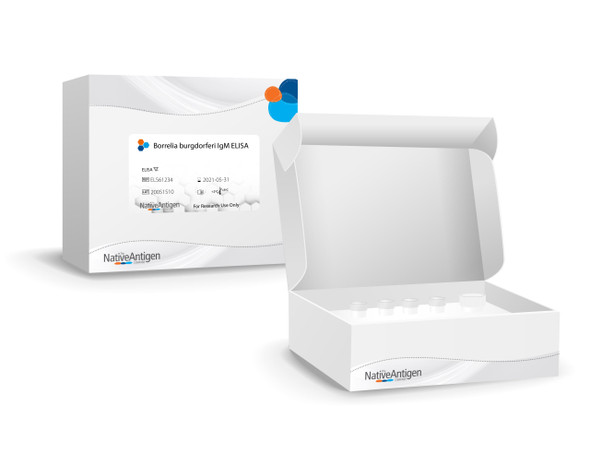Description
BORRELIA BURGDORFERI IGG ELISA
Borrelia burgdorferi IgG ELISA has been developed for the detection B. Burgdoferi. B. burgdorferi belongs to the family of spirochetes, of which three types have been identified to be pathogenic to humans: Borrelia burgdorferi sensu stricto, B. afzelii and B. garinii.
PRODUCT DETAILS – BORRELIA BURGDORFERI IGG ELISA
- ELISA for the detection of IgG antibodies against Borrelia burgdorferi.
- 0.99U/ml sensitivity and 97% specificity.
- Assay time of under 3 hours.
BACKGROUND
The endemic areas of Borrelia are in Central and Eastern Europe, as well as Russia, China and Japan. The illness is transferred via tick bites, in Europe mainly by Ixodes ricinus. In endemic zones, like Southern Germany and Austria, up to 50% of ticks are infected. In the clinical course, after an erythema migrans, e.g. with neuroborreliosis, which appears at the first stage, chronical arthritis, encephalitis, meningitis, myositis and hepatitis are also observed. Treatment is usually by different antibiotics, e.g. doxycyclin, amoxicillin, cefuroxim and penicillin G. Specific immunization is possible with immunoprophylaxis either by a recombinant OspA or by a recombinant polyvalent OspC vaccine. Laboratory diagnosis is performed by the detection of antibodies in blood and cerebrospinal fluid. Methods employed are ELISA, immunofluorescence, hemagglutination or Western blot. Besides whole cell extracts, purified or recombinant single proteins are increasingly used as antigens. This generally results however in a decrease in sensitivity. It has been shown that there are significant differences between the various test methods used for interpretation and the most reliable method seems to be the follow-up of titer development. Western blot serves as a confirmatory test, because electrophoretically separated single antigens can be evaluated in their reaction with specific serum antibodies.
Borrelia burgdorferi IgG ELISA is based on the principle of the enzyme immunoassay (EIA). Borrelia burgdorferi antigen is bound on the surface of the microtiter strips. Diluted serum or ready-to-use standards are pipetted into the wells of the microtiter plate. A binding between the IgG antibodies of the serum and the immobilized Borrelia burgdorferi antigen takes place. After one-hour incubation at room temperature, the plate is rinsed with diluted wash solution, in order to remove unbound material. Then ready-to-use anti-human-IgG peroxidase conjugate is added and incubated for 30 minutes. After a further washing step, the substrate (TMB) solution is pipetted and incubated for 20 minutes, inducing the development of a blue dye in the wells. The color development is terminated by the addition of a stop solution, which changes the color from blue to yellow. The resulting dye is measured spectrophotometrically at a wavelength of 450 nm. The concentration of IgG antibodies is directly proportional to the intensity of the color. The Borrelia burgdorferi IgG ELISA test kit contains both a whole cell antigen extract of Borrelia burgdorferi sensu stricto (which cross-reacts with Borrelia afzelii and Borrelia garinii) and pure OspC, which greatly increases the specificity and sensitivity of the assay.
THIS ELISA ASSAY IS FOR RESEARCH USE ONLY. IT IS NOT FOR USE IN DIAGNOSTIC PROCEDURES.













